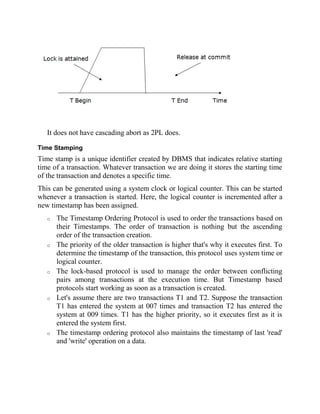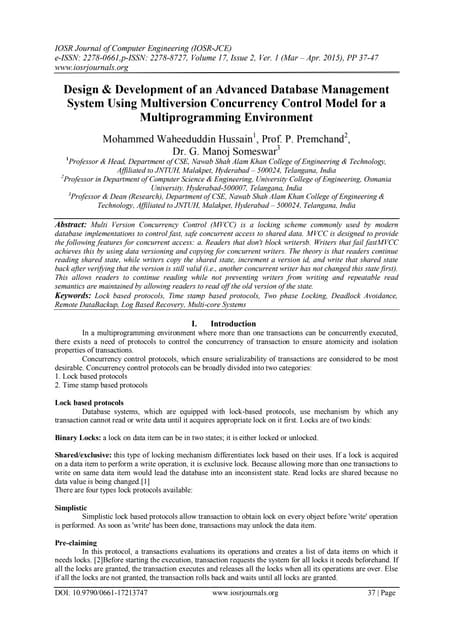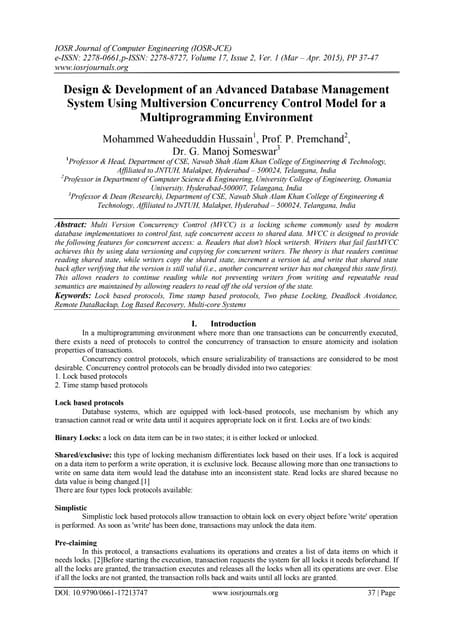Concurrency note.pdf
0 likes97 views
Concurrency control in database management systems allows multiple transactions to execute simultaneously without conflicts. It maintains consistency by coordinating access to shared data. Common techniques include locking, which reserves access to data for a transaction, and timestamp ordering, which sequences transactions based on their start time. Locking approaches include two-phase locking for serializable isolation and protocols that handle lock requests and conversions. Timestamp ordering rejects transactions that violate precedence relations between read and write timestamps of data items.
1 of 6
Download to read offline

![ï· Uncommitted Dependency or dirty read problem â On variable has updated in one
transaction, at the same time another transaction has started and deleted the
value of the variable there the variable is not getting updated or committed
that has been done on the first transaction this gives us false values or the
previous values of the variables this is a major problem.
ï· Inconsistent retrievals â One transaction is updating multiple different variables,
another transaction is in a process to update those variables, and the problem
occurs is inconsistency of the same variable in different instances.
Concurrency control techniques
The concurrency control techniques are as follows â
Locking
Lock guaranties exclusive use of data items to a current transaction. It first
accesses the data items by acquiring a lock, after completion of the transaction it
releases the lock.
Types of Locks
The types of locks are as follows â
1. Shared Lock [Transaction can read only the data item values]
It is also known as a Read-only lock. In a shared lock, the data item can only
read by the transaction.
It can be shared between the transactions because when the transaction holds a
lock, then it can't update the data on the data item.
2. Exclusive Lock [Used for both read and write data item values]
In the exclusive lock, the data item can be both reads as well as written by
the transaction.
This lock is exclusive, and in this lock, multiple transactions do not modify
the same data simultaneously.](https://image.slidesharecdn.com/concurrencynote-221127115626-d65c1ae5/85/Concurrency-note-pdf-2-320.jpg)




Recommended
Concurrency Control



Concurrency ControlNishant Munjal
Ėý
Concurrency control techniques ensure transactions are executed atomically and isolated. There are two main types - lock-based and timestamp-based protocols. Lock-based protocols use locks to control access to data during read/write operations. Timestamp protocols order transactions based on their timestamp to ensure serializability. Distributed transactions involve statements that access data on multiple database nodes. Replication improves availability by storing copies of data at different sites.Concurrency control PPT



Concurrency control PPTShushrutGupta
Ėý
Powerpoint Presentaion on Concurrency Control Protocols,
is part of Btech 3rd year DBMS syllabus.
This slide is part of assignment provided during session 2018-2019DBMS Presentation.pptx



DBMS Presentation.pptxPravinBhargav1
Ėý
This ppt is about the Data Base Management System and there are described the concurrency control technique.F017213747



F017213747IOSR Journals
Ėý
This document discusses the design and development of an advanced database management system using multiversion concurrency control. It begins with an abstract discussing how MVCC allows readers to access shared data without blocking writers by using data versioning. It then covers various concurrency control protocols like lock-based, timestamp-based, and their types. It also discusses techniques for deadlock handling, failure recovery, and remote data backup for catastrophic failures. The document provides details on how MVCC can be implemented to allow concurrent read and write access in a database system.Design & Development of an Advanced Database Management System Using Multiver...



Design & Development of an Advanced Database Management System Using Multiver...IOSR Journals
Ėý
The document describes research on developing an advanced database management system using multiversion concurrency control. It discusses how multiversion concurrency control allows readers to continue reading without blocking writers by using data versioning. It also summarizes different concurrency control protocols like lock-based protocols, time stamp ordering protocols, and two-phase locking. The research aims to design a system that uses multiversion concurrency control to provide features like readers that don't block writers and writers that fail fast in a multiprogramming environment.F017213747



F017213747IOSR Journals
Ėý
The document describes research on developing an advanced database management system using multiversion concurrency control. It discusses how multiversion concurrency control allows readers to continue reading without blocking writers by using data versioning. It also summarizes different concurrency control protocols like lock-based and timestamp-based protocols. Lock-based protocols include simplistic, pre-claiming, two-phase locking and strict two-phase locking. Timestamp-based protocols use timestamps to determine the order of transactions. The research also studies methods to prevent deadlocks in the system, such as wait-die and wound-wait schemes.Advanced Database Chapter 4.pdf shnsbxlajmndm woweosmkl m,xcnkl C NOOxcx xcbnxc



Advanced Database Chapter 4.pdf shnsbxlajmndm woweosmkl m,xcnkl C NOOxcx xcbnxcalemunuruhak9
Ėý
A distributed system is designed to help create applications and services that can use many independent computers. These computers do not share memory but work together by sending messages over a network.
Transaction management



Transaction managementjanani thirupathi
Ėý
This document discusses transaction management and concurrency control. It summarizes two main categories of concurrency control protocols: lock-based protocols and timestamp-based protocols. For lock-based protocols, it describes four types: simplistic locking, pre-claiming, two-phase locking (2PL), and strict 2PL. For timestamp-based protocols, it explains how each transaction is assigned a timestamp and how read/write rules ensure serializability based on timestamp ordering.Concurrency control ms neeti



Concurrency control ms neetineeti arora
Ėý
This document discusses concurrency control in database management systems. Concurrency control addresses conflicts that can occur with simultaneous data access or alteration by multiple users. It ensures transactions are performed concurrently without violating data integrity. The document provides examples of concurrency control issues and describes different concurrency control protocols, including lock-based protocols that use locks to control access to data being read or written, and timestamp-based protocols that use timestamps to determine the order of transactions.Concurrency control ms neeti



Concurrency control ms neetineeti arora
Ėý
This document discusses concurrency control in database management systems. Concurrency control addresses conflicts that can occur with simultaneous data access or alteration by multiple users. It ensures transactions are performed concurrently without violating data integrity. The document provides examples of concurrency control issues and describes different concurrency control protocols including lock-based and timestamp-based approaches. Lock-based protocols use locks to control access to data being read or written while timestamp-based protocols use timestamps to determine the order of transactions.Dbms voc 5 unit



Dbms voc 5 unitgurjotkawatra
Ėý
A transaction is a logical unit of work that accesses and possibly modifies the database. It includes one or more database
operations that must either all be completed or all rolled back together to maintain database consistency. Transactions must
have ACID properties - Atomicity, Consistency, Isolation, and Durability to ensure data integrity during concurrent
execution. Concurrency control techniques like locking and timestamps are used to isolate transactions and maintain
serializability. Recovery techniques use a log to roll back or redo incomplete transactions and restore the database to a
consistent state after failures.Concurrency control



Concurrency controlJaved Khan
Ėý
Concurrency control protocols control simultaneous transactions in a database. There are two main categories: lock-based and timestamp-based. Lock-based protocols use locks to control access to data, which can be in exclusive or shared mode. Timestamp-based protocols assign timestamps to transactions and data items to determine if operations can be executed or must be rejected. Optimistic concurrency control validates transactions in three phases: execution, validation, and commit, enforcing rules to ensure serializability.Mba ebooks ! Edhole



Mba ebooks ! EdholeEdhole.com
Ėý
Concurrency control techniques allow simultaneous access to a database while preserving data integrity. This document discusses locking techniques like pessimistic and optimistic locking. It also covers topics like deadlocks, timestamps, validation-based protocols, and multi-version schemes. Multi-version concurrency control allows readers to access consistent past versions of data even if it is currently being written. This avoids locking overhead and provides point-in-time consistent views for read transactions. Maintaining multiple versions with timestamps achieves consistency without transactions blocking each other.Unit 5 dbms



Unit 5 dbmsSweta Singh
Ėý
Concurrency Control Techniques: Concurrency Control, Locking Techniques for Concurrency
Control, Time Stamping Protocols for Concurrency Control, Validation Based Protocol, Multiple
Granularity, Multi Version Schemes, Recovery with Concurrent Transaction,Rdbms



Rdbmssakthibalabalamuruga
Ėý
Deadlocks can occur in distributed database systems when transactions are waiting for data locked by other transactions across multiple sites. There are three main approaches to handle deadlocks - prevention, avoidance, and detection/removal. For avoidance and detection/removal, issues like transaction location and control must be addressed due to the distributed nature. Avoidance algorithms abort or wait transactions based on age to prevent deadlocks proactively. Detection builds global wait-for-graphs to identify deadlock cycles and remove the deadlock.Rdbms



Rdbmssakthibalabalamuruga
Ėý
Deadlocks can occur in distributed database systems when transactions are waiting for data locked by other transactions across multiple sites. There are three main approaches to handle deadlocks - prevention, avoidance, and detection/removal. For avoidance and detection/removal, issues like transaction location and control must be addressed due to the distributed nature. Avoidance algorithms abort or wait younger transactions depending on a distributed wait-die or wound-wait approach. Detection builds global wait-for-graphs to detect cycles indicating deadlocks across sites.Transaction management



Transaction managementArchanaMani2
Ėý
This document discusses database transactions and concurrency control. It defines a transaction, describes the ACID properties of atomicity, consistency, isolation, and durability. It explains the different states a transaction can be in, types of transactions, scheduling, and serializability. The document also defines concurrency control and discusses two common concurrency control protocols: shared/exclusive locking and two phase locking.Vani dbms



Vani dbmsSangeethaSasi1
Ėý
This document discusses concurrency control and its protocols. Concurrency control ensures correct results from concurrent operations while maximizing performance. It addresses issues that can arise from multiple transactions executing simultaneously on the same data. The ACID rules of atomicity, consistency, isolation, and durability are explained. Common concurrency control protocols include lock-based, two phase locking, and timestamp-based protocols. Lock-based protocols use shared and exclusive locks to control access to data. Two phase locking follows a growing and shrinking phase approach. Timestamp-based protocols serialize transactions based on timestamps.DBMS UNIT 4



DBMS UNIT 4Dr. SURBHI SAROHA
Ėý
This document provides an overview of transaction processing and recovery in database management systems. It discusses topics like transaction processing, concurrency control techniques including locking and timestamping protocols, recovery from transaction failures using log-based recovery, and checkpoints. The key aspects covered are the ACID properties of transactions, serialization testing using precedence graphs, recoverable schedules, and concurrency control methods like locking, timestamp ordering, and validation-based protocols.Databases: Locking Methods



Databases: Locking MethodsDamian T. Gordon
Ėý
The document discusses various locking methods used in database transactions. It describes two-phase locking where transactions acquire locks in the first phase and release locks in the second phase. It also discusses problems that can occur with locking like deadlocks and livelocks. Methods to prevent deadlocks like ordering locks or transactions are presented. Timestamp based methods like wait-die and wound-wait are explained. Finally, optimistic methods are introduced where transactions validate for conflicts at commit time before writing updates.concurrencycontrol from power pint pdf a



concurrencycontrol from power pint pdf aMdAyanParwez
Ėý
The document discusses various concurrency control protocols used to maintain database consistency with concurrent transactions. It describes lock-based protocols that use locks to control concurrent access to data items. Lock-based protocols include two-phase locking and graph-based protocols. It also discusses timestamp-based and validation-based concurrency control protocols that utilize timestamps and validation phases respectively to ensure serializability.Overview of Concurrency Control & Recovery in Distributed Databases



Overview of Concurrency Control & Recovery in Distributed DatabasesMeghaj Mallick
Ėý
This is an PPT of DBMS. It include the following topic such as" Overview of Concurrency Control & Recovery in Distributed Databases"Unit 4 Concurrency control.pptx dbms lovely



Unit 4 Concurrency control.pptx dbms lovelyPritishMajumdar3
Ėý
The document discusses various concurrency control protocols used to maintain database consistency with concurrent transaction execution. It describes lock-based protocols that use locks to control transaction access to shared data, including two-phase locking and various lock types. It also summarizes timestamp-based and validation-based protocols as alternative approaches to concurrency control.Unit 4 Concurrency control.pptx dbms lovely



Unit 4 Concurrency control.pptx dbms lovelyPritishMajumdar3
Ėý
The document discusses various concurrency control protocols used to maintain database consistency with concurrent transaction execution. It describes lock-based protocols that use locks to control transaction access to shared data, including two-phase locking and various lock types. It also summarizes timestamp-based and validation-based protocols as alternative approaches to concurrency control.Concurrency Control.pptx



Concurrency Control.pptxVijaySourtha
Ėý
This document discusses various concurrency control protocols used to manage concurrent access to databases. It describes lock-based protocols that use locking mechanisms to control access. It also covers timestamp-based protocols that order transactions based on timestamps to ensure serializability. Finally, it discusses validation-based or optimistic protocols that validate transactions have not violated consistency before committing writes.VALIDATION BASED PROTOCOL AND MULTIPLE GRANULARITY.pptx



VALIDATION BASED PROTOCOL AND MULTIPLE GRANULARITY.pptxSamyakJain710491
Ėý
This document discusses validation based protocol, an optimistic concurrency control technique used in database management systems. It has three phases - read, validation, and write. In the read phase, transactions read data into local variables without updating the database. In the validation phase, a test checks for serializability violations between transactions. If there are no violations, the transaction commits its writes to the database in the write phase. The protocol uses timestamps to order transactions and avoid conflicts. It can avoid cascading rollbacks but has a risk of starvation for long transactions. The document also discusses multiple granularity locking, which defines a hierarchy of data sizes from fine to coarse granularity to control concurrent access.concurrency-control



concurrency-controlSaranya Natarajan
Ėý
- Concurrency control manages simultaneous database operations to prevent interference. This avoids issues like lost updates, dirty reads, and incorrect summaries.
- Lock-based protocols use locks to control concurrent access. Timestamp-based protocols assign timestamps to transactions to determine execution order.
- The two-phase locking protocol acquires all locks in a "growing" phase before releasing any locks in a "shrinking" phase, ensuring serializability. Variations include strict two-phase locking and rigorous two-phase locking.
- Timestamp-based protocols assign timestamps to transactions and check for conflicts between read/write operations and timestamps to ensure serial ordering. Thomas' write rule modifies checking for some write operations.APM London Network: Essentials of a Good PMO, 2 April 2025



APM London Network: Essentials of a Good PMO, 2 April 2025Association for Project Management
Ėý
APM London Network: Essentials of a Good PMO, 2 April 2025
Presented by Aalok Sonawala and Magali Bruna
Whether supporting a project, programme or portfolio, a PMO brings many benefits to any project-based organisation.
During this event, we will discuss the need and importance of establishing a PMO within project-based organisations. Additionally, we will outline the different types of PMO, their key elements, and how these are best employed within an organisation.
Along with the best ways to implement PMOs, we will discuss the key benefits they can bring to your project, programme or portfolio. From ensuring your projects are effectively controlled to creating a Centre of Excellence and Best Practice guidelines.
We will delve into the key elements of PMO, such as providing guidance on topics such as Governance, Assurance and Risk, to creating design and workplace standards.
The event promises to provide valuable insights on PMOs, and also provides a great opportunity to knowledge-share ideas and network with like-minded colleagues.More Related Content
Similar to Concurrency note.pdf (20)
Concurrency control ms neeti



Concurrency control ms neetineeti arora
Ėý
This document discusses concurrency control in database management systems. Concurrency control addresses conflicts that can occur with simultaneous data access or alteration by multiple users. It ensures transactions are performed concurrently without violating data integrity. The document provides examples of concurrency control issues and describes different concurrency control protocols, including lock-based protocols that use locks to control access to data being read or written, and timestamp-based protocols that use timestamps to determine the order of transactions.Concurrency control ms neeti



Concurrency control ms neetineeti arora
Ėý
This document discusses concurrency control in database management systems. Concurrency control addresses conflicts that can occur with simultaneous data access or alteration by multiple users. It ensures transactions are performed concurrently without violating data integrity. The document provides examples of concurrency control issues and describes different concurrency control protocols including lock-based and timestamp-based approaches. Lock-based protocols use locks to control access to data being read or written while timestamp-based protocols use timestamps to determine the order of transactions.Dbms voc 5 unit



Dbms voc 5 unitgurjotkawatra
Ėý
A transaction is a logical unit of work that accesses and possibly modifies the database. It includes one or more database
operations that must either all be completed or all rolled back together to maintain database consistency. Transactions must
have ACID properties - Atomicity, Consistency, Isolation, and Durability to ensure data integrity during concurrent
execution. Concurrency control techniques like locking and timestamps are used to isolate transactions and maintain
serializability. Recovery techniques use a log to roll back or redo incomplete transactions and restore the database to a
consistent state after failures.Concurrency control



Concurrency controlJaved Khan
Ėý
Concurrency control protocols control simultaneous transactions in a database. There are two main categories: lock-based and timestamp-based. Lock-based protocols use locks to control access to data, which can be in exclusive or shared mode. Timestamp-based protocols assign timestamps to transactions and data items to determine if operations can be executed or must be rejected. Optimistic concurrency control validates transactions in three phases: execution, validation, and commit, enforcing rules to ensure serializability.Mba ebooks ! Edhole



Mba ebooks ! EdholeEdhole.com
Ėý
Concurrency control techniques allow simultaneous access to a database while preserving data integrity. This document discusses locking techniques like pessimistic and optimistic locking. It also covers topics like deadlocks, timestamps, validation-based protocols, and multi-version schemes. Multi-version concurrency control allows readers to access consistent past versions of data even if it is currently being written. This avoids locking overhead and provides point-in-time consistent views for read transactions. Maintaining multiple versions with timestamps achieves consistency without transactions blocking each other.Unit 5 dbms



Unit 5 dbmsSweta Singh
Ėý
Concurrency Control Techniques: Concurrency Control, Locking Techniques for Concurrency
Control, Time Stamping Protocols for Concurrency Control, Validation Based Protocol, Multiple
Granularity, Multi Version Schemes, Recovery with Concurrent Transaction,Rdbms



Rdbmssakthibalabalamuruga
Ėý
Deadlocks can occur in distributed database systems when transactions are waiting for data locked by other transactions across multiple sites. There are three main approaches to handle deadlocks - prevention, avoidance, and detection/removal. For avoidance and detection/removal, issues like transaction location and control must be addressed due to the distributed nature. Avoidance algorithms abort or wait transactions based on age to prevent deadlocks proactively. Detection builds global wait-for-graphs to identify deadlock cycles and remove the deadlock.Rdbms



Rdbmssakthibalabalamuruga
Ėý
Deadlocks can occur in distributed database systems when transactions are waiting for data locked by other transactions across multiple sites. There are three main approaches to handle deadlocks - prevention, avoidance, and detection/removal. For avoidance and detection/removal, issues like transaction location and control must be addressed due to the distributed nature. Avoidance algorithms abort or wait younger transactions depending on a distributed wait-die or wound-wait approach. Detection builds global wait-for-graphs to detect cycles indicating deadlocks across sites.Transaction management



Transaction managementArchanaMani2
Ėý
This document discusses database transactions and concurrency control. It defines a transaction, describes the ACID properties of atomicity, consistency, isolation, and durability. It explains the different states a transaction can be in, types of transactions, scheduling, and serializability. The document also defines concurrency control and discusses two common concurrency control protocols: shared/exclusive locking and two phase locking.Vani dbms



Vani dbmsSangeethaSasi1
Ėý
This document discusses concurrency control and its protocols. Concurrency control ensures correct results from concurrent operations while maximizing performance. It addresses issues that can arise from multiple transactions executing simultaneously on the same data. The ACID rules of atomicity, consistency, isolation, and durability are explained. Common concurrency control protocols include lock-based, two phase locking, and timestamp-based protocols. Lock-based protocols use shared and exclusive locks to control access to data. Two phase locking follows a growing and shrinking phase approach. Timestamp-based protocols serialize transactions based on timestamps.DBMS UNIT 4



DBMS UNIT 4Dr. SURBHI SAROHA
Ėý
This document provides an overview of transaction processing and recovery in database management systems. It discusses topics like transaction processing, concurrency control techniques including locking and timestamping protocols, recovery from transaction failures using log-based recovery, and checkpoints. The key aspects covered are the ACID properties of transactions, serialization testing using precedence graphs, recoverable schedules, and concurrency control methods like locking, timestamp ordering, and validation-based protocols.Databases: Locking Methods



Databases: Locking MethodsDamian T. Gordon
Ėý
The document discusses various locking methods used in database transactions. It describes two-phase locking where transactions acquire locks in the first phase and release locks in the second phase. It also discusses problems that can occur with locking like deadlocks and livelocks. Methods to prevent deadlocks like ordering locks or transactions are presented. Timestamp based methods like wait-die and wound-wait are explained. Finally, optimistic methods are introduced where transactions validate for conflicts at commit time before writing updates.concurrencycontrol from power pint pdf a



concurrencycontrol from power pint pdf aMdAyanParwez
Ėý
The document discusses various concurrency control protocols used to maintain database consistency with concurrent transactions. It describes lock-based protocols that use locks to control concurrent access to data items. Lock-based protocols include two-phase locking and graph-based protocols. It also discusses timestamp-based and validation-based concurrency control protocols that utilize timestamps and validation phases respectively to ensure serializability.Overview of Concurrency Control & Recovery in Distributed Databases



Overview of Concurrency Control & Recovery in Distributed DatabasesMeghaj Mallick
Ėý
This is an PPT of DBMS. It include the following topic such as" Overview of Concurrency Control & Recovery in Distributed Databases"Unit 4 Concurrency control.pptx dbms lovely



Unit 4 Concurrency control.pptx dbms lovelyPritishMajumdar3
Ėý
The document discusses various concurrency control protocols used to maintain database consistency with concurrent transaction execution. It describes lock-based protocols that use locks to control transaction access to shared data, including two-phase locking and various lock types. It also summarizes timestamp-based and validation-based protocols as alternative approaches to concurrency control.Unit 4 Concurrency control.pptx dbms lovely



Unit 4 Concurrency control.pptx dbms lovelyPritishMajumdar3
Ėý
The document discusses various concurrency control protocols used to maintain database consistency with concurrent transaction execution. It describes lock-based protocols that use locks to control transaction access to shared data, including two-phase locking and various lock types. It also summarizes timestamp-based and validation-based protocols as alternative approaches to concurrency control.Concurrency Control.pptx



Concurrency Control.pptxVijaySourtha
Ėý
This document discusses various concurrency control protocols used to manage concurrent access to databases. It describes lock-based protocols that use locking mechanisms to control access. It also covers timestamp-based protocols that order transactions based on timestamps to ensure serializability. Finally, it discusses validation-based or optimistic protocols that validate transactions have not violated consistency before committing writes.VALIDATION BASED PROTOCOL AND MULTIPLE GRANULARITY.pptx



VALIDATION BASED PROTOCOL AND MULTIPLE GRANULARITY.pptxSamyakJain710491
Ėý
This document discusses validation based protocol, an optimistic concurrency control technique used in database management systems. It has three phases - read, validation, and write. In the read phase, transactions read data into local variables without updating the database. In the validation phase, a test checks for serializability violations between transactions. If there are no violations, the transaction commits its writes to the database in the write phase. The protocol uses timestamps to order transactions and avoid conflicts. It can avoid cascading rollbacks but has a risk of starvation for long transactions. The document also discusses multiple granularity locking, which defines a hierarchy of data sizes from fine to coarse granularity to control concurrent access.concurrency-control



concurrency-controlSaranya Natarajan
Ėý
- Concurrency control manages simultaneous database operations to prevent interference. This avoids issues like lost updates, dirty reads, and incorrect summaries.
- Lock-based protocols use locks to control concurrent access. Timestamp-based protocols assign timestamps to transactions to determine execution order.
- The two-phase locking protocol acquires all locks in a "growing" phase before releasing any locks in a "shrinking" phase, ensuring serializability. Variations include strict two-phase locking and rigorous two-phase locking.
- Timestamp-based protocols assign timestamps to transactions and check for conflicts between read/write operations and timestamps to ensure serial ordering. Thomas' write rule modifies checking for some write operations.Recently uploaded (20)
APM London Network: Essentials of a Good PMO, 2 April 2025



APM London Network: Essentials of a Good PMO, 2 April 2025Association for Project Management
Ėý
APM London Network: Essentials of a Good PMO, 2 April 2025
Presented by Aalok Sonawala and Magali Bruna
Whether supporting a project, programme or portfolio, a PMO brings many benefits to any project-based organisation.
During this event, we will discuss the need and importance of establishing a PMO within project-based organisations. Additionally, we will outline the different types of PMO, their key elements, and how these are best employed within an organisation.
Along with the best ways to implement PMOs, we will discuss the key benefits they can bring to your project, programme or portfolio. From ensuring your projects are effectively controlled to creating a Centre of Excellence and Best Practice guidelines.
We will delve into the key elements of PMO, such as providing guidance on topics such as Governance, Assurance and Risk, to creating design and workplace standards.
The event promises to provide valuable insights on PMOs, and also provides a great opportunity to knowledge-share ideas and network with like-minded colleagues.Bioinformatics: History of Bioinformatics, Components of Bioinformatics, Geno...



Bioinformatics: History of Bioinformatics, Components of Bioinformatics, Geno...A Biodiction : A Unit of Dr. Divya Sharma
Ėý
Bioinformatics: History of Bioinformatics, Components of Bioinformatics, Genome Analysis, Sequence Alignment, Phylogenetic Analysis
All India Council of Skills and Vocational Studies (AICSVS) PROSPECTUS 2025



All India Council of Skills and Vocational Studies (AICSVS) PROSPECTUS 2025National Council of Open Schooling Research and Training
Ėý
All India Council of Vocational Skills (AICSVS) and National Council of Open Schooling Research and Training (NCOSRT), Global International University, Asia Book of World Records (ABWRECORDS), International a joint Accreditation Commission of Higher Education (IACOHE)The prospectus is going to be published in the year 2025ISO 42001 2023 Audit and Control Checklist



ISO 42001 2023 Audit and Control Checklistpriyanshamadhwal2
Ėý
As Artificial Intelligence continues to evolve, ensuring responsible, ethical, and regulatory-compliant AI governance is more critical than ever. This comprehensive audit checklist designed to help organizations align with ISO/IEC 42001:2023, the first global standard for AI management systems.
ð Whatâs Inside?
âAI Management System (AIMS) audit framework
âKey compliance factors covering risk, ethics and accountability
âReadiness evaluation for AI-driven organizations
âActionable steps to align with ISO/IEC 42001:2023How to process Interwarehouse and Intrawarehouse transfers in Odoo



How to process Interwarehouse and Intrawarehouse transfers in OdooCeline George
Ėý
Inventory management is a critical component of any business that deals with physical goods. In Odoo, the Inventory module provides a comprehensive solution for managing stock, tracking inventory movements, and optimizing supply chain operations.Developing Topic and Research Question for Systematic Reviews - Emmanuel Ekpor



Developing Topic and Research Question for Systematic Reviews - Emmanuel EkporSystematic Reviews Network (SRN)
Ėý
The topic and research question forms the foundation of the entire systematic review.
A poorly defined topic/question leads to:
Unfocused search strategy
Irrelevant studies
Weak synthesis and conclusionsBUSINESS QUIZ | THE QUIZ CLUB OF PSGCAS | 17TH MARCH 2025 .pptx



BUSINESS QUIZ | THE QUIZ CLUB OF PSGCAS | 17TH MARCH 2025 .pptxQuiz Club of PSG College of Arts & Science
Ėý
The Quiz club of PSGCAS brings you another fun-filled trivia ride. Presenting you a Business quiz with 20 sharp questions to feed your intellectual stimulus. So, sharpen your business mind for this quiz set
Quizmaster: Thanvanth N A, BA Economics, The Quiz Club of PSG College of Arts & Science (2023-26 batch)3. AI Trust Layer, Governance â Explainability, Security & Compliance.pdf



3. AI Trust Layer, Governance â Explainability, Security & Compliance.pdfMukesh Kala
Ėý
AI Trust Layer, Governance â Explainability, Security & ComplianceStrategic Corporate Social Responsibility: Sustainable Value Creation Fourth



Strategic Corporate Social Responsibility: Sustainable Value Creation Fourthkeileyrazawi
Ėý
Strategic Corporate Social Responsibility: Sustainable Value Creation Fourth
Strategic Corporate Social Responsibility: Sustainable Value Creation Fourth
Strategic Corporate Social Responsibility: Sustainable Value Creation FourthKnownsense 2025 Finals-U-25 General Quiz.pdf



Knownsense 2025 Finals-U-25 General Quiz.pdfPragya - UEM Kolkata Quiz Club
Ėý
Knownsense is the General Quiz conducted by Pragya the Official Quiz Club of the University of Engineering and Management Kolkata in collaboration with Ecstasia the official cultural fest of the University of Engineering and Management Kolkata Knownsense 2025 prelims- U-25 General Quiz.pdf



Knownsense 2025 prelims- U-25 General Quiz.pdfPragya - UEM Kolkata Quiz Club
Ėý
General College Quiz conducted by Pragya the Official Quiz Club of the University of Engineering and Management Kolkata in collaboration with Ecstasia the official cultural fest of the University of Engineering and Management Kolkata.McElaney "What is inclusive publishing and why do we care about accessibility...



McElaney "What is inclusive publishing and why do we care about accessibility...National Information Standards Organization (NISO)
Ėý
This presentation was provided by Jack McElaney of Microassist during the initial session of the NISO training series "Accessibility Essentials." Session One: The Introductory Seminar was held April 3, 2025.10.socialorganisationandsocialsystem .pptx



10.socialorganisationandsocialsystem .pptxVivek Bhattji
Ėý
SOCIAL ORGANIATION & SOCIAL DISORGANIZATION
APPLIED SOCIOLOGY How to manage Customer Tips with Odoo 17 Point Of Sale



How to manage Customer Tips with Odoo 17 Point Of SaleCeline George
Ėý
In the context of point-of-sale (POS) systems, a tip refers to the optional amount of money a customer leaves for the service they received. It's a way to show appreciation to the cashier, server, or whoever provided the service.Action of Muscles ppt by Priscilla Jasper Vedam Vemavarapu @ASRHMC



Action of Muscles ppt by Priscilla Jasper Vedam Vemavarapu @ASRHMCjaspervedamvemavarap
Ėý
Action of muscles-Anatomy
Contraction and relaxation
Muscle tone
Length and tension relationship
Types of muscle contraction
Active and passive insufficiency
Shunt and sprunt muscles
Agonists
Antagonists
Fixators
Synergists
Conrad "Accessibility Essentials: Introductory Seminar"



Conrad "Accessibility Essentials: Introductory Seminar"National Information Standards Organization (NISO)
Ėý
This presentation was provided by Lettie Conrad of LibLynx and San JosÃĐ University during the initial session of the NISO training series "Accessibility Essentials." Session One: The Introductory Seminar was held April 3, 2025.Unit No 4- Chemotherapy of Malignancy.pptx



Unit No 4- Chemotherapy of Malignancy.pptxAshish Umale
Ėý
In the Pharmacy profession there are many dangerous diseases from which the most dangerous is cancer. Here we study about the cancer as well as its treatment that is supportive to the students of semester VI of Bachelor of Pharmacy. Cancer is a disease of cells of characterized by Progressive, Persistent, Perverted (abnormal), Purposeless and uncontrolled Proliferation of tissues. There are many types of cancer that are harmful to the human body which are responsible to cause the disease condition. The position 7 of guanine residues in DNA is especially susceptible. Cyclophosphamide is a prodrug converted to the active metabolite aldophosphamide in the liver. Procarbazine is a weak MAO inhibitor; produces sedation and other CNS effects, and can interact with foods and drugs. Methotrexate is one of the most commonly used anticancer drugs. Methotrexate (MTX) is a folic acid antagonist. 6-MP and 6-TG are activated to their ribonucleotides, which inhibit purine ring biosynthesis and nucleotide inter conversion. Pyrimidine analogue used in antineoplastic, antifungal and anti psoriatic agents.
5-Fluorouracil (5-FU) is a pyrimidine analog. It is a complex diterpin taxane obtained from bark of the Western yew tree. Actinomycin D is obtained from the fungus of Streptomyces species. Gefitinib and Erlotinib inhibit epidermal growth factor receptor (EGFR) tyrosine kinase. Sunitinib inhibits multiple receptor tyrosine kinases like platelet derived growth factor (PDGF) Rituximab target antigen on the B cells causing lysis of these cells.
Prednisolone is 4 times more potent than hydrocortisone, also more selective glucocorticoid, but fluid retention does occur with high doses. Estradiol is a major regulator of growth for the subset of breast cancers that express the estrogen receptor (ER, ESR1).
Finasteride and dutasteride inhibit conversion of testosterone to dihydrotestosterone in prostate (and other tissues), have palliative effect in advanced carcinoma prostate; occasionally used. Chemotherapy in most cancers (except curable cancers) is generally palliative and suppressive. Chemotherapy is just one of the modes in the treatment of cancer. Other modes like radiotherapy and surgery are also employed to ensure 'total cell kill'.Unit No. 4 - Immunopharmacologyslides.pptx



Unit No. 4 - Immunopharmacologyslides.pptxAshish Umale
Ėý
The branch of pharmacology concerned with the immune system. Immunopharmacology is the study of the effects of the drugs modifying immune mechanism in body. It includes not only inoculation but also autoimmune disorders, allergic reactions, and cancer. IMMUNITY is the ability of the living body or the process to resist various types of organisms or toxins that tend to damage the tissue and organs.Immunostimulants and immunomodulators are drugs that modulate the immune response and can be used to increase the immune responsiveness of patients with Immunodeficiency as in AIDS, chronic illness and cancers.
Vaccines and antisera are used for immunization against bacterial and viral infections.
Synthesized originally as an anthelmintic but appears to restore depressed immune function of B lymphocytes, T lymphocytes, monocytes and macrophages.
Interferons alpha and beta are mainly used for antiviral effects while interferon a for its immunomodulating actions.
Cyclosporine is a cyclic peptide antibiotic produced by a fungus Beauveria nivea.
Cyclosporine acts at an early stage, selectively inhibits T cell proliferation and suppresses cell-mediated immunity.
Azathioprine is a prodrug of mercaptopurine which is a purine analog.
TNFa is secreted by activated macrophages and other immune cells to act on TNF receptors (TNFR1, TNFR2) which are located on the surface of neutrophils, fibroblasts, endothelial cells as well as found in free soluble form in serum and serous fluids.
Etanercept is also used for severe/refractory ankylosing spondylitis, polyarticular idiopathic juvenile arthritis and plaque psoriasis
Anakinra along with continued MTX has been used alone as well as added to Tnfa antagonists, because its clinical efficacy as monotherapy is lower.Use of immunosuppressants is essential for successful organ transplantation.
A glucocorticoid like methylprednisolone for 3-5 days generally suppresses acute rejection episodes
Bioinformatics: History of Bioinformatics, Components of Bioinformatics, Geno...



Bioinformatics: History of Bioinformatics, Components of Bioinformatics, Geno...A Biodiction : A Unit of Dr. Divya Sharma
Ėý
All India Council of Skills and Vocational Studies (AICSVS) PROSPECTUS 2025



All India Council of Skills and Vocational Studies (AICSVS) PROSPECTUS 2025National Council of Open Schooling Research and Training
Ėý
Developing Topic and Research Question for Systematic Reviews - Emmanuel Ekpor



Developing Topic and Research Question for Systematic Reviews - Emmanuel EkporSystematic Reviews Network (SRN)
Ėý
BUSINESS QUIZ | THE QUIZ CLUB OF PSGCAS | 17TH MARCH 2025 .pptx



BUSINESS QUIZ | THE QUIZ CLUB OF PSGCAS | 17TH MARCH 2025 .pptxQuiz Club of PSG College of Arts & Science
Ėý
McElaney "What is inclusive publishing and why do we care about accessibility...



McElaney "What is inclusive publishing and why do we care about accessibility...National Information Standards Organization (NISO)
Ėý
Conrad "Accessibility Essentials: Introductory Seminar"



Conrad "Accessibility Essentials: Introductory Seminar"National Information Standards Organization (NISO)
Ėý
Concurrency note.pdf
- 1. Concurrency Control in DBMS Concurrency control concept comes under the Transaction in database management system (DBMS). It is a procedure in DBMS which helps us for the management of two simultaneous processes to execute without conflicts between each other, these conflicts occur in multi user systems. Concurrency can simply be said to be executing multiple transactions at a time. It is required to increase time efficiency. If many transactions try to access the same data, then inconsistency arises. Concurrency control required to maintain consistency data. For example, if we take ATM machines and do not use concurrency, multiple persons cannot draw money at a time in different places. This is where we need concurrency. Advantages The advantages of concurrency control are as follows â ï· Waiting time will be decreased. ï· Response time will decrease. ï· Resource utilization will increase. ï· System performance & Efficiency is increased. Control concurrency The simultaneous execution of transactions over shared databases can create several data integrity and consistency problems. For example, if too many people are logging in the ATM machines, serial updates and synchronization in the bank servers should happen whenever the transaction is done, if not it gives wrong information and wrong data in the database. Main problems in using Concurrency The problems which arise while using concurrency are as follows â ï· Updates will be lost â One transaction does some changes and another transaction deletes that change. One transaction nullifies the updates of another transaction.
- 2. ï· Uncommitted Dependency or dirty read problem â On variable has updated in one transaction, at the same time another transaction has started and deleted the value of the variable there the variable is not getting updated or committed that has been done on the first transaction this gives us false values or the previous values of the variables this is a major problem. ï· Inconsistent retrievals â One transaction is updating multiple different variables, another transaction is in a process to update those variables, and the problem occurs is inconsistency of the same variable in different instances. Concurrency control techniques The concurrency control techniques are as follows â Locking Lock guaranties exclusive use of data items to a current transaction. It first accesses the data items by acquiring a lock, after completion of the transaction it releases the lock. Types of Locks The types of locks are as follows â 1. Shared Lock [Transaction can read only the data item values] It is also known as a Read-only lock. In a shared lock, the data item can only read by the transaction. It can be shared between the transactions because when the transaction holds a lock, then it can't update the data on the data item. 2. Exclusive Lock [Used for both read and write data item values] In the exclusive lock, the data item can be both reads as well as written by the transaction. This lock is exclusive, and in this lock, multiple transactions do not modify the same data simultaneously.
- 3. There are four types of lock protocols available: 1. Simplistic lock protocol It is the simplest way of locking the data while transaction. Simplistic lock-based protocols allow all the transactions to get the lock on the data before insert or delete or update on it. It will unlock the data item after completing the transaction. 2. Pre-claiming Lock Protocol Pre-claiming Lock Protocols evaluate the transaction to list all the data items on which they need locks. Before initiating an execution of the transaction, it requests DBMS for all the lock on all those data items. If all the locks are granted then this protocol allows the transaction to begin. When the transaction is completed then it releases all the lock. If all the locks are not granted then this protocol allows the transaction to rolls back and waits until all the locks are granted. 3. Two-phase locking (2PL) o The two-phase locking protocol divides the execution phase of the transaction into three parts. o In the first part, when the execution of the transaction starts, it seeks permission for the lock it requires.
- 4. o In the second part, the transaction acquires all the locks. The third phase is started as soon as the transaction releases its first lock. o In the third phase, the transaction cannot demand any new locks. It only releases the acquired locks. There are two phases of 2PL: Growing phase: In the growing phase, a new lock on the data item may be acquired by the transaction, but none can be released. Shrinking phase: In the shrinking phase, existing lock held by the transaction may be released, but no new locks can be acquired. In the below example, if lock conversion is allowed then the following phase can happen: 1. Upgrading of lock (from S(a) to X (a)) is allowed in growing phase. 2. Downgrading of lock (from X(a) to S(a)) must be done in shrinking phase.
- 5. It does not have cascading abort as 2PL does. Time Stamping Time stamp is a unique identifier created by DBMS that indicates relative starting time of a transaction. Whatever transaction we are doing it stores the starting time of the transaction and denotes a specific time. This can be generated using a system clock or logical counter. This can be started whenever a transaction is started. Here, the logical counter is incremented after a new timestamp has been assigned. o The Timestamp Ordering Protocol is used to order the transactions based on their Timestamps. The order of transaction is nothing but the ascending order of the transaction creation. o The priority of the older transaction is higher that's why it executes first. To determine the timestamp of the transaction, this protocol uses system time or logical counter. o The lock-based protocol is used to manage the order between conflicting pairs among transactions at the execution time. But Timestamp based protocols start working as soon as a transaction is created. o Let's assume there are two transactions T1 and T2. Suppose the transaction T1 has entered the system at 007 times and transaction T2 has entered the system at 009 times. T1 has the higher priority, so it executes first as it is entered the system first. o The timestamp ordering protocol also maintains the timestamp of last 'read' and 'write' operation on a data.
- 6. Basic Timestamp ordering protocol works as follows: 1. Check the following condition whenever a transaction Ti issues a Read (X) operation: o If W_TS(X) >TS(Ti) then the operation is rejected. o If W_TS(X) <= TS(Ti) then the operation is executed. o Timestamps of all the data items are updated. 2. Check the following condition whenever a transaction Ti issues a Write(X) operation: If TS(Ti) < R_TS(X) then the operation is rejected. If TS(Ti) < W_TS(X) then the operation is rejected and Ti is rolled back otherwise the operation is executed. Where TS(TI) denotes the timestamp of the transaction Ti. R_TS(X) denotes the Read time-stamp of data-item X. W_TS(X) denotes the Write time-stamp of data-item X. Advantages and Disadvantages of TO protocol: o TO protocol ensures serializability since the precedence graph is as follows: o TS protocol ensures freedom from deadlock that means no transaction ever waits. o But the schedule may not be recoverable and may not even be cascade- free.


